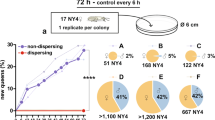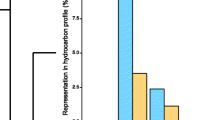Abstract
Fertile queens of the antMonomorium pharaonis produce a chemical substance which is not present in worker ants or in young, alate (virgin) queens. The material has been identified as (E,E,E)-1-isopropenyl-4,8,12-trimethylcyclotetradeca-3,7,11-triene (neocembrene). This chemical is produced in the Dufour's gland of fertile queens and may serve as a queen-recognition pheromone.
Similar content being viewed by others
References
Berndt, K.P. 1977. Physiology of reproduction in the pharaoh's ant (Monomorium pharaonis L.). 1. Pheromone mediated cyclic production of sexuals.Wiad. Parazytol. 23:163–166.
Berndt, K.P., andNitschmann, J. 1979. The physiology of reproduction in the pharaoh's ant (Monomorium pharaonis L.) 2. The unmated queens.Insectes Soc. 26:137–145.
Birch, A.J., Brown, W.V., Corrie, J.E.T., andMoore, B.P. 1972. Neocembrene-A, a termite trail pheromone.J Chem. Soc. Perkin I 1972:2653–2658.
Blum, M.S., Jones, T.H., Holldobler, B., Fales, H.M., andJaouni, T. 1980. Alkaloidal venom mace: Offensive use by a thief ant.Naturwissenschaften. 67:144–145.
Bradshaw, J.W., Baker, R., andHowse, P.E. 1975. Multicomponent alarm pheromones of the weaver ant.Nature 258:230–231.
Brian, M.V. 1973. Queen recognition by brood-rearing workers of the antMyrmica rubra L.Anim. Behav. 21:691–698.
Butler, C.G. 1961. The scent of queen honeybees (A. mellifera L.) that causes partial inhibition of queen rearing.J. Insect Physiol. 7:258–264.
Butler, C.G. Callow, R.K., andJohnston, N.C. 1962. The isolation and synthesis of queen substance 9-oxodec-trans-2-enoic acid, a honeybee pheromone.Proc. R. Soc. London, Ser. B 155:417–432.
Dash, V.B., andKashyap, V.L. 1980. Materia Medica of Ayurveda, Vol. 1. Concept Publishing, New Delhi, 711 pp.
Edwards, J.P. 1975. The effects of a juvenile hormone analogue on laboratory colonies of pharaoh's ant,Monomorium pharaonis (L.) (Hymenoptera, Formicidae).Bull. Entomol. Res. 65:75–80.
Edwards, J.P., andPinniger, D.B. 1978. Evaluation of four isomers of 3-butyl-5-methylocta-hydroindolizine, a component of the trail pheromone of pharaoh's ant,Monomorium pharaonis.Ann. Appl. Biol. 89:395–399.
Fowler, H.G., andRoberts, R.B. 1982. Entourage pheromone in carpenter ant (Camponotus pennsylvanicus) (Hymenoptera: Formicidae) queens.J. Kans. Entomol. Soc. 55:568–570.
Holldobler, B. 1973. Chemische Strategie beim Nahrungserwerb der Diebsameise (Solenopsis fugax Latr.) und der Pharaoameise (Monomorium pharaonis L.)Oecologia 11:371–380.
Holldobler, B., andWust, M. 1973. Ein Sexualpheromon bei der PharaomeiseMonomorium pharaonis (L.).Z. Tierpsychol. 32:1–9.
Jones, T.H., Blum, M.S., Howard, R.W., McDaniel, C.A., Fales, H.M., Dubois, M.B., andTorres, J. 1982. Venom chemistry of ants in the genusMonomorium.J. Chem. Ecol. 8:285–300.
Jones, T.H., Blum, M.S., andFales, H.M. 1979. Synthesis of unsymmetrical 2,5-di-n-alkylpyrrolidines: 2-Hexyl-5-pentylpyrrolidine from the thief antsSolenopsis molesta andS. texanus, and its homologues.Tetrahedron Lett. 12:1031–1034.
Jouvenaz, D.P., Banks, W.A., andLofgren, C.S. 1974. Fire ants: Attraction of workers to queen's secretion.Ann. Entomol. Soc. Am. 67:442–444.
Kato, T., Suzuki, M., Kobayashi, T., andMoore, B.P. 1980. Synthesis and pheromone activities of optically active neocembrenes and their geometrical isomers, (E,Z,E)- and (E,E,Z)- neocembrenes.J. Org. Chem. 45:1126–1130.
Kobayashi, M., Koyama, T., Ogura, K., Seto, S., Ritter, F.J., andBruggemann-Rotgans, I.E.M. 1980. Bioorganic synthesis and absolute configuration of faranal.J. Am. Chem. Soc. 102:6602–6604.
Kodama, M., Matsuki, Y., andIto, S. 1975. Syntheses of macrocyclic terpenoids by intramolecular cyclization I. (+)-Cembrene-A, a termite trail pheromone, and (+)-nephthenol.Tetrahedron Lett. 1975:3065–3068.
Legakis, A. 1980. Aspects of chemical communication in pharaoh's ant,Monomorium pharaonis (L.). PhD thesis, Southampton University.
Miyamoto, F., Naoki, H., Takemoto, T., andNaya, Y. 1979. New macrocyclic sesterterpenoids from a scale insect (Ceroplastes ceriferus).Tetrahedron 35:1913–1917.
Moore, B.P. 1966. Isolation of the scent-trail pheromones of an Australian termite.Nature 211:746–747.
Patil, V.D., Nayak, U.R., andDev, S. 1973. Chemistry of ayurvedic crude drugs—II Guggulu (resin fromCommiphora mukul), 2:Diterpenoid constituents.Tetrahedron 29:341–348.
Peacock, A.D., Smith, I.C., Hall, D.W., andBaxter, A.T. 1954. Studies in Pharaoh's antMonomorium pharaonis (8). Male production by parthenogenesis.Entomol. Mon. Mag. 90:154–158.
Pedder, D.J., Fales, H.M., Jaouni, T., Blum, M., MaCconnell, J., andCrewe, R.M. 1976. Constitutents of the venom of a South African fire ant (Solenopsis punctaticeps) 2,5-dialkyl pyrrolidines and -pyrrolines, identification and synthesis.Tetrahedron 32:2275–2279.
Petersen-Braun, M. 1975. Untersuchungen zur Sozialen Organization der PharaoameiseMonomorium pharaonis (L.) (Hymenoptera, Formicidae) 1. Der Brutzyklus und seine Steuerung durch populationseigene Faktoren.Insectes Soc. 22:269–292.
Ritter, F.J., Rotans, I.E., Talman, E., Verwiel, P.E., andStein, F. 1973. 5-Methyl-3-butyloctahydroindolizine, a novel type of pheromone attractive to pharaoh's antsMonomorium pharaonis (L.).Experientia 29:530–531.
Ritter, F.J., Bruggemann-Rotgans, I.E., Verkuil, E., andPersoons, C.J. 1975. The trail pheromone of the pharaoh's ant: Components of the odour trail and their origin,in C.H. Noirot, P.E. Howse, and G. Le Masne (eds.). Pheromones and Defensive Secretions in Social Insects. University of Dijon, Dijon.
Ritter, F.J., Bruggemann-Rotgans, I.E., Verwiel, P.E., Persoons, C.J., andTalman, E. 1977. Trail pheromone of the pharaoh's antMonomorium pharaonis: Isolation and identification of faranal, a terpenoid related to juvenile hormone II.Tetrahedron Lett. 30:2617–2618.
Ritter, F.J., Bruggemann, I.E.M., Verweil, P.E., Talman, E., Stein, F., andPersoons, C.J. 1981. Faranal and monomorines, pheromones of the Pharaoh's ant,Monomorium pharaonis (L.), pp. 871–881,in Regulation of Insect Development and Behaviour, Vol. II. M. Kloza (ed.). Wroclaw Technical University Press, Wroclaw.
Rocca, J.R., Tumlinson, J.H., Glancey, B.M., andLofgren, C.S. 1983a. The queen recognition pheromone ofSolenopsis invicta, preparation of (E)-6-(l-pentenyl)-2H-pyran-2-one.Tetrahedron Lett. 24:1889–1892.
Rocca, J.R., Tumlinson, J.H., Glancey, B.M., andLofgren, C.S. 1983b. Synthesis and stereochemistry of tetrahydro-3,5-dimethyl-6-(1-methylbutyl)-2H-pyran-2-one, a component of the queen recognition pheromone ofSolenopsis invicta.Tetrahedron Lett. 24:1893–1896.
Shmidt, E.N., Kashtanova, N.K., andPentegov, V.A. 1970. Neocembrene—a new diterpene hydrocarbon fromPicea obovata andPinus koraensis.Chem. Nat. Comp. (Part 2) 6:705–707.
Stumper, R. 1956. Etudes myrmecologiques 77: Les sécrétions attractives des reines de fourmis.Mitt. Schweiz. Entomol. Ges. 29:373–380.
Talman, E. Ritter, F.J., andVerwiel, P.E. 1974. Structure elucidation of pheromones produced by the pharaoh's antMonomorium pharaonis (L.), pp. 197–217,in Mass Spectrometry in Biochemistry and Medicine. A. Frigerio and N. Castagnoli (eds.) Raven Press, New York.
Vander Meer, R.K., Glancey, B.M., Lofgren, C.S., Glover, A., Tumlinson, J.H., andRocca, J. 1980. The poison sac of red imported fire ant queens: Source of a pheromone attractant.Ann. Entomol. Soc. Am. 73:609–612.
Wiemer, D.F., Meinwald, J., Prestwich, G.D., andMiura, I. 1979. Cembrene A and (3Z)-cembrene A: Diterpenes from a termite soldier (Isoptera: Termitidae, Termitinae).J. Org. Chem. 44:3950–3952.
Wilson, E.O. 1971. The Insect Societies. Harvard Universiity Press, Cambridge, Massachusetts, 548 pp.
Author information
Authors and Affiliations
Rights and permissions
About this article
Cite this article
Edwards, J.P., Chambers, J. Identification and source of a queen-specific chemical in the pharaoh's ant,Monomorium pharaonis (L.). J Chem Ecol 10, 1731–1747 (1984). https://doi.org/10.1007/BF00987358
Received:
Revised:
Issue Date:
DOI: https://doi.org/10.1007/BF00987358




